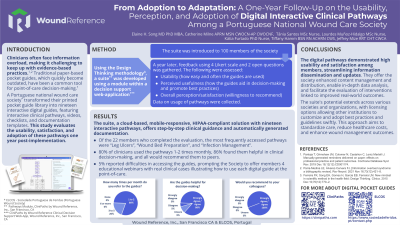Practice Innovations
(PI-039) From Adoption to Adaptation: A One-year Follow-up on the Usability, Perception, and Adoption of Digital Interactive Clinical Pathways Among a Portuguese National Wound Care Society
Friday, May 2, 2025
7:45 PM - 8:45 PM East Coast USA Time

Catherine Milne, MSN, APRN, ANP/ACNC-BC, CWOCN-AP, WOCNF; Tânia Santos, MSc, Nurse.; Lourdes Muñoz-Hidalgo, MSc, Nurse.; Kátia Furtado, PhDs, Nurse.; Tiffany Hamm, BSN, RN, ACHRN, CWS; Jeffery Mize, RRT, CHT, CWCA – WoundReference, Inc.
Introduction:
Introduction: Clinicians often face information overload, making it challenging to keep up with evidence-based practices.1,2 Traditional paper-based pocket guides, which quickly become outdated, have been a common tool for point-of-care decision-making.1Having information digital information readily available allows wound care providers of all types rapid access to ever-changing practice recommendations.
A Portuguese national wound care society* transformed their printed pocket guide library into nineteen interactive digital guides, featuring interactive clinical pathways, videos, checklists, and documentation templates and disseminated among 100 Society members. This study evaluates the usability, satisfaction, and adoption of these pathways one-year post-implementation.
Methods:
Methods: A year later, an evaluation form within the platform gathered feedback using 4 Likert scale and 2 open questions. This assessed usability (how easy and often the guides are used), perceived usefulness (how the guides aid in decision-making and promote best practices), and overall perception/satisfaction (willingness to recommend). Data on the frequency of pathway usage were independently collected.
Results:
Results: Of the 22 members who completed the evaluation, the most frequently accessed pathways were “Leg Ulcers,” “Wound Bed Preparation,” and “Infection Management.” Eighty percent of clinicians used the pathways 1-2 times monthly; 86% found them helpful in clinical decision-making; and all would recommend them to peers. Five percent reported difficulties in accessing the guides, prompting the Society to offer members 4 educational webinars with clinical cases illustrating how to use each digital guide at the point-of-care.
Discussion:
Discussion: The digital pathways demonstrated high usability and satisfaction among members, streamlining information dissemination and updates. They offer the society enhanced content management and distribution, enable in-depth data analysis, and facilitate the evaluation of interventions linked to improved real-world outcomes. This approach aims to standardize care, reduce healthcare costs, and enhance wound management outcomes.
Introduction: Clinicians often face information overload, making it challenging to keep up with evidence-based practices.1,2 Traditional paper-based pocket guides, which quickly become outdated, have been a common tool for point-of-care decision-making.1Having information digital information readily available allows wound care providers of all types rapid access to ever-changing practice recommendations.
A Portuguese national wound care society* transformed their printed pocket guide library into nineteen interactive digital guides, featuring interactive clinical pathways, videos, checklists, and documentation templates and disseminated among 100 Society members. This study evaluates the usability, satisfaction, and adoption of these pathways one-year post-implementation.
Methods:
Methods: A year later, an evaluation form within the platform gathered feedback using 4 Likert scale and 2 open questions. This assessed usability (how easy and often the guides are used), perceived usefulness (how the guides aid in decision-making and promote best practices), and overall perception/satisfaction (willingness to recommend). Data on the frequency of pathway usage were independently collected.
Results:
Results: Of the 22 members who completed the evaluation, the most frequently accessed pathways were “Leg Ulcers,” “Wound Bed Preparation,” and “Infection Management.” Eighty percent of clinicians used the pathways 1-2 times monthly; 86% found them helpful in clinical decision-making; and all would recommend them to peers. Five percent reported difficulties in accessing the guides, prompting the Society to offer members 4 educational webinars with clinical cases illustrating how to use each digital guide at the point-of-care.
Discussion:
Discussion: The digital pathways demonstrated high usability and satisfaction among members, streamlining information dissemination and updates. They offer the society enhanced content management and distribution, enable in-depth data analysis, and facilitate the evaluation of interventions linked to improved real-world outcomes. This approach aims to standardize care, reduce healthcare costs, and enhance wound management outcomes.

.jpg)
